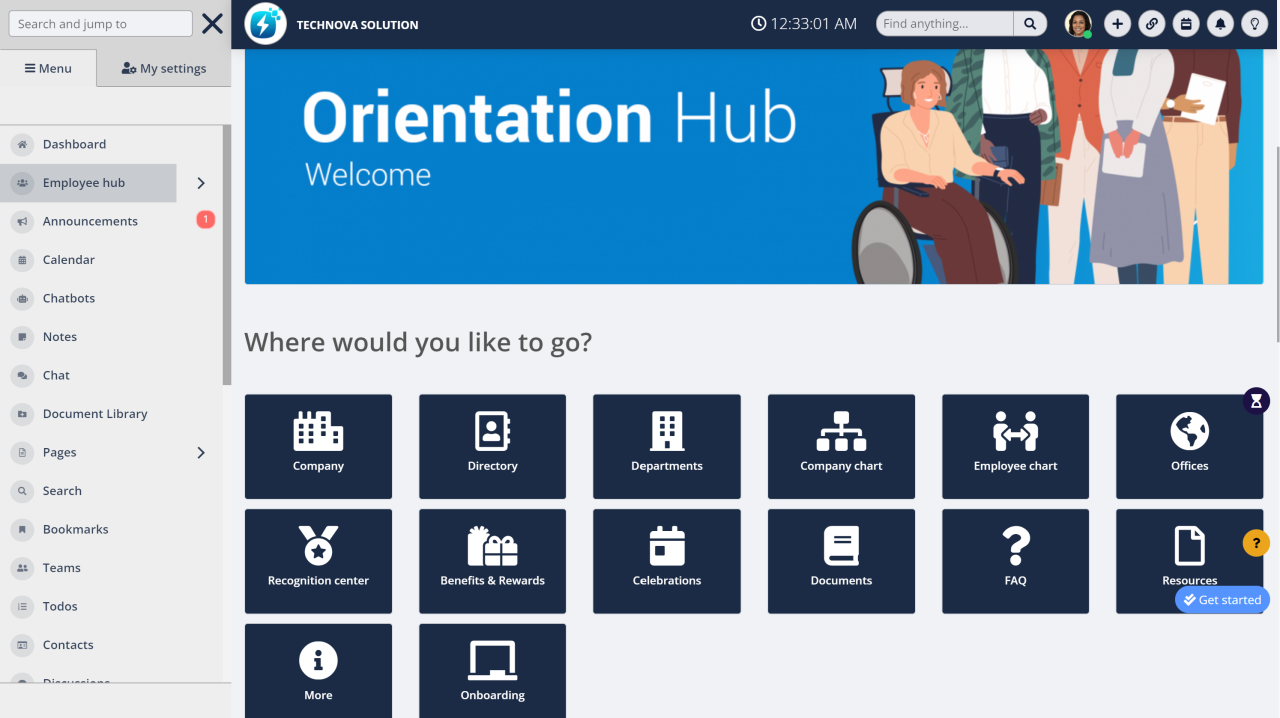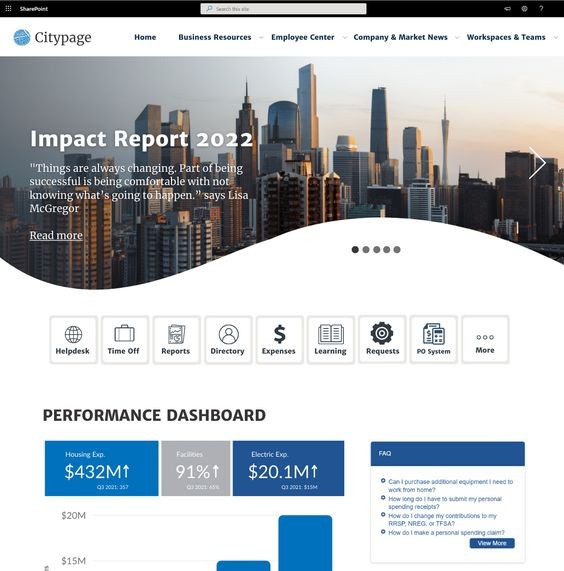Insight Blog
Agility’s perspectives on transforming the employee's experience throughout remote transformation using connected enterprise tools.
17 minutes reading time
(3320 words)
Best Bank Intranet Software | UPDATED 2023 | A Complete Guide
In this article, we delve into the concept of intranets and explore the Best Bank Intranet Software in 2023. Keep reading to gain insight into how banks harness this technology to enhance internal communication and engage their employees.
In this article, we delve into the concept of intranets and explore the different Bank Intranet Software in 2023. Keep reading to gain insight into how banks harness this technology to enhance internal communication and engage their employees.
The rapidly evolving financial industry had long been in need of technological solutions that could bolster knowledge management and internal communication.
Consequently, financial organizations are increasingly opting to adopt intranet solutions tailored specifically for the banking industry.
This strategic choice results in not only smoother information flow but also enhanced overall operational efficiency and elevated customer service quality.
This strategic choice results in not only smoother information flow but also enhanced overall operational efficiency and elevated customer service quality.
Nonetheless, what essential features should a meticulously designed bank intranet encompass?
What Is an Bank Intranet?
An intranet serves as an internal computer network within an organization, facilitating the sharing of information, tools, and various resources.
In the context of a modern intranet, it provides a highly user-friendly interface for seamlessly disseminating a wide range of content, from the latest company updates to collaborative documents. Think of it as a central workspace that streamlines and simplifies various work-related tasks.The primary objective of an intranet portal is to enhance group collaboration and productivity.
Additionally, it offers a heightened level of security in comparison to internet-based applications, given that access to the intranet is restricted to individuals within the organization.
This heightened security is particularly valuable for businesses operating in the finance sector.
An intranet is a private network that is used within an organization to share information and resources among employees. It is similar to the internet, but it is not accessible to the public. Intranets can be used for a variety of purposes, including:
- Communication: Intranets can be used to communicate with employees about company news, policies and procedures, and other important information. They can also be used to facilitate communication between employees in different departments or locations.
- Collaboration: Intranets can be used to support collaboration on projects and tasks. This can be done through features such as file sharing, discussion forums, and project management tools.
- Knowledge management: Intranets can be used to store and share knowledge within the organization. This can be done through features such as knowledge bases, wikis, and document repositories.
- Business processes: Intranets can be used to automate and streamline business processes. For example, employees can use intranets to submit vacation requests, approve invoices, or order supplies.
Intranets can be a valuable tool for organizations of all sizes. They can help to improve communication, collaboration, and knowledge management, which can lead to increased productivity and efficiency. So we will move on to Bank Intranet Software and the advantages of using an intranet.
The Advantages of Using an Intranet
Increases employee productivity and engagement
Utilizing an intranet within the workplace offers numerous advantages for both employees and management.
One of the most significant benefits lies in the enhanced productivity and increased engagement of employees. The implementation of an employee intranet portal serves to unite your workforce, creating an environment where employees' voices can be heard, and their opinions valued. An eye-opening Gallup study revealed that 65% of U.S. employees lack engagement at work.
Furthermore, research conducted by The McKinsey Global Institute has recently shown that companies witnessing a 20-25% boost in productivity are those where employees are interconnected, both with each other and the company.
This surge in productivity can translate into tangible ROI for your organization, leading to cost savings simply by providing a platform for employee connectivity.
Moreover, this platform serves as a centralized hub that offers all the essential tools and resources employees require to efficiently carry out their tasks, eliminating the need for constant switching between various platforms and further enhancing productivity.
Open Banking Integration
Amidst financial technology's evolution, open banking integration has become a linchpin for modern financial institutions. This integration facilitated through APIs, allows digital banks and financial institutions to share customer financial data with third-party service providers.
As we explore the intricacies of intranet solutions tailored for the banking industry, understanding the transformative impact of open banking on collaboration, security, and customer experience is paramount.
If you're exploring integration solutions, look for an expertised fintech software development company that stands ready to assist. Such partners can ensure a seamless and secure implementation tailored to your unique needs.
Enhances collaboration and communication
Another advantage of an intranet lies in its capacity to enhance employee collaboration, teamwork, and communication.
Features that enable document sharing, commenting, and collaborative editing create opportunities for employees to collaborate on projects, regardless of their physical locations.
A well-designed employee intranet portal not only offers designated spaces for each department to share information and collaborate on tasks but also fosters cross-departmental communication.
This cross-functional interaction unlocks a wealth of knowledge that might remain untapped in environments with inadequate company-wide communication and collaboration.
Furthermore, the inherent emphasis that company intranet portals place on communication contributes to greater transparency in the workplace. It communicates to your employees that effective communication ranks as a top priority within your organization.Includes document storage
Outdated content and knowledge management systems can lead employees to waste countless hours navigating through inefficiencies.
They may find themselves struggling to recall where a specific document or piece of information was stored or sifting through an overwhelming volume of files. The value of an intranet in such circumstances lies in its role as a centralized repository for all data and documents.
Equipped with an effective search engine, your employees can easily locate the information they need by conducting searches within the intranet portal.
This not only enhances productivity but also streamlines data management across the organization.
Moreover, crucial working documents can be made more accessible, and items like employee handbooks and PTO (Paid Time Off) forms can be stored in an intuitive and efficient manner.
Empowering employees with readily available knowledge at their fingertips fosters self-sufficiency, allowing other team members to focus on their respective tasks.
When all content and documentation are organized under one virtual roof, it offers a wealth of knowledge to employees for various research needs or information necessary to complete their assignments.
Always have access
After your company deploys an intranet portal for employees, they gain the flexibility to access it from any device with internet connectivity, regardless of location or time.
This liberates them from being tethered to a desktop computer within the office, as cloud-based intranet portals ensure that everything is accessible from virtually anywhere.
This feature proves especially beneficial for employees who are frequently on the move, such as those traveling for business purposes.
In line with the mobile-centric trend, most intranets also provide a dedicated mobile intranet app.
Why? Well, organizations recognize the significant amount of time people spend on their mobile devices. In 2020, more than 5.7 billion individuals worldwide owned smartphones. Studies indicate that people dedicate over 76,500 hours of their lives to mobile phone usage, which equates to nearly 9 years.
Furthermore, these studies reveal that Millennials are the most avid users, spending an average of 3.7 hours per day on their mobile phones.
Examples of how intranets are used in different industries:
- Communication: Intranets can be used to communicate with employees about bank news, policies and procedures, and other important information. They can also be used to facilitate communication between employees in different branches or departments. For example, an intranet could be used to share updates on new products and services, to provide training on compliance regulations, or to facilitate communication between customer service representatives and loan officers.
- Collaboration: Intranets can be used to support collaboration on projects and tasks. This can be done through features such as file sharing, discussion forums, and project management tools. For example, an intranet could be used to share documents related to a new product launch or to coordinate the efforts of a team working on a new IT project.
- Knowledge management: Intranets can be used to store and share knowledge within the bank. This can be done through features such as knowledge bases, wikis, and document repositories. For example, an intranet could be used to store and share information about the bank's products and services, its policies and procedures, or its best practices.
- Business processes: Intranets can be used to automate and streamline business processes. For example, employees could use an intranet to submit vacation requests, approve invoices, or order supplies.
What Features Should an Intranet for Banks Have?
The finance industry imposes unique technology requirements on banks and financial institutions. Compliance with regulations like PCI and ethical obligations to safeguard customer information are paramount. Consequently, transitioning between technologies isn't always a straightforward endeavor.
As a result, numerous financial organizations find themselves reliant on traditional intranets built on legacy technologies. While these solutions may have limitations, they align with the regulatory demands of the business.
As a result, numerous financial organizations find themselves reliant on traditional intranets built on legacy technologies. While these solutions may have limitations, they align with the regulatory demands of the business.
Switching to an AgilityPortal intranet solution could offer a compelling solution for your business.
Here are some of the key features to look out for when shopping for a new intranet.
Follow us and access great exclusive content everyday: Follow us on Google News
Employee Data Analytics:
Include employee analytics in your financial intranet. You can gather this information much like other websites collect user data. The best intranet solution collects data on the applications your employees use, how they use them, and when. With this data, you can identify redundancies and opportunities for improvement.
Document Enhancements:
Document organization within libraries should be user-friendly. You can share documents across the entire company or within specific departments and categorize them with content tagging. Tagged content improves searchability, filtering, and data presentation.
You may also like: Best Apps for Employees: UPDATED 2022 – A Complete Guide
Link Enhancements:
A robust bank intranet solution should allow you to create and share links to internal or external resources, whether for team or personal use. This feature should be customizable, offering both custom and preloaded icons in a classic box or simple list format.
Efficiency Boost:
Enterprises risk losing thousands of productive hours annually because employees struggle to locate essential resources for their work. A well-designed intranet enables you to find documents, colleagues, news, and more in one centralized location, contributing to organizational efficiency.
Interface Organization:
Choose an intranet with a highly organized user interface designed to maximize efficiency. It should be customizable to align with your unique needs.
Organizational Information:
Top financial intranets prioritize end-user experience. Your solution should provide an internal news feed to keep everyone informed about exciting developments. Additionally, it should facilitate two-way communication through built-in options for forms and polls, encouraging open and honest dialogues.
Staff Directories and Flowcharts:
Utilize staff directories and flowcharts to easily locate colleagues, even if you can't recall their names. These tools enhance workplace efficiency and reduce awkward moments.
FAQ's:
FAQs are invaluable for maintaining spam-free inboxes and preserving employees' focus by avoiding mass email blasts. They streamline Q&A processes, allowing administrators to update FAQs as needed.
Pre-Built SharePoint Templates:
Pre-built SharePoint templates simplify the implementation of new features, ensuring a consistent interface with maximum functionality.
Speed
Time is money, and a speedy, reliable bank intranet is essential. Financial institutions benefit significantly from increased efficiency, contributing to their bottom line.
Aesthetics:
While functionality is critical, an aesthetically pleasing intranet encourages employee engagement. When employees appreciate the design, they are more likely to use your financial intranet regularly, ultimately boosting ROI.
Security:
Bank intranets demand the highest level of security to safeguard customer information. Compliance with security regulations is a legal requirement. A financial intranet should offer customizable security settings, granting control over data access.
Iteration:
In the fast-paced tech world, a static, unupdated intranet can become obsolete quickly. A hubley intranet doesn't lock you into a stagnant environment. Quarterly updates keep your intranet fresh and relevant, with many ideas stemming from user feedback. We value user input and continuously seek to enhance the user experience.
Free ebook: How To Get Your Intranet Off The Ground
Best Bank Intranet Software – A Complete Guide
When choosing the ideal intranet solution for your needs, there are intangible factors to consider. Some of these considerations can be guided by advice, while others are learned through experience with a vendor.
First and foremost, assess the customer service and support provided by a vendor to their existing clients.
First and foremost, assess the customer service and support provided by a vendor to their existing clients.
This aspect speaks volumes about their commitment to resolving issues and whether their focus is primarily on acquiring new business. It's crucial to gather insights from as many existing customers as possible, not just those recommended by the vendor.
Engage with industry peers, attend events, and have informal discussions to gain a holistic perspective. Our reports even feature a 'voice of the customer' section, highlighting real customer experiences to provide a starting point.
Sometimes vendors concentrate on developing new features and overlook older parts of their offerings. When speaking to existing customers, inquire about any shortcomings they've encountered with the product and whether the vendor updates it frequently enough to meet their needs.
Lastly, the vendor's culture significantly influences your working relationship, especially since contracts often span several years.
During informal interactions, pay attention to the vendor's culture, and consider the following questions:
Sometimes vendors concentrate on developing new features and overlook older parts of their offerings. When speaking to existing customers, inquire about any shortcomings they've encountered with the product and whether the vendor updates it frequently enough to meet their needs.
Lastly, the vendor's culture significantly influences your working relationship, especially since contracts often span several years.
- Have they conducted basic research about your business, demonstrating an understanding of your users and products/services?
- Did they make an effort to tailor a demo for you, incorporating branding elements from your website into their presentation?
- Is their communication style aligned with your preferences and the nature of your business, whether it's formal or more relaxed?
- How persistent are they in their communications? Do they maintain contact for updates, even when you've indicated that significant timeframes are involved?
Ultimately, trust your instincts and don't settle. If uncertainty persists, continue asking questions or be open to exploring other options.
Bank Intranet Examples
Here are a few examples:
1.AgilityPortal
AgilityPortal is a cloud-based intranet and employee communication platform.
It is designed to help businesses of all sizes to engage, communicate, and collaborate with their employees.
AgilityPortal offers a wide range of features, including:
- Employee directory: A central place to store and manage employee information, such as contact details, job titles, and departments.
- Company news and announcements: A way to share important news and announcements with employees across the company.
- Team collaboration: Tools to help teams communicate and collaborate on projects, such as discussion forums, file sharing, and task management.
- Knowledge base: A central place to store and share company knowledge, such as policies and procedures, training materials, and FAQs.
- Employee engagement tools: Tools to help boost employee morale and engagement, such as surveys, polls, and social media integration.
AgilityPortal is a mobile-friendly platform, so employees can access it from anywhere, on any device. It is also highly customizable, so businesses can tailor it to their specific needs.
AgilityPortal is a popular choice for businesses of all sizes, from small businesses to large enterprises. It is used by a wide range of industries, including healthcare, education, finance, and technology.
Here are some of the benefits of using AgilityPortal:
- Improved employee communication and collaboration: AgilityPortal provides a central place for employees to communicate and collaborate with each other. This can help to improve productivity and efficiency.
- Increased employee engagement: AgilityPortal offers a variety of tools to help boost employee morale and engagement. This can lead to a happier and more productive workforce.
- Reduced costs: AgilityPortal is a cloud-based platform, so businesses do not need to invest in expensive hardware and software. This can save businesses money in the long run.
If you are looking for a way to improve employee communication, collaboration, and engagement, then AgilityPortal is a good option to consider.
2.SharePoint
SharePoint is a web-based collaborative platform that integrates with Microsoft 365.
It allows users to store, organize, share, and access information from anywhere, on any device.
SharePoint can be used to create a variety of different types of sites, including:
- Team sites: These sites are used to collaborate on projects and share information with team members.
- Communication sites: These sites are used to share news and information with a broader audience, such as employees, customers, or partners.
- Intranet sites: These sites are used to provide employees with access to company resources, such as policies and procedures, training materials, and FAQs.
- Knowledge bases: These sites are used to store and share company knowledge, such as how-to guides, troubleshooting tips, and best practices.
SharePoint also offers a variety of features to help users collaborate more effectively, such as:
- Document libraries: These libraries allow users to store and share documents with others.
- Lists: These lists can be used to track data, such as tasks, events, and contacts.
- Workflows: These workflows can be used to automate tasks and processes.
- Forms: These forms can be used to collect data from users.
- Web parts: These web parts can be added to pages to display content, such as news, calendars, and polls.
SharePoint is a powerful tool that can be used to improve communication, collaboration, and productivity in organizations of all sizes and the use of Sharepoint Lookbook is an added tip.
What Is Sharepoint Lookbook: SharePoint Lookbook typically includes various templates for different types of sites, such as team sites, communication sites, and hub sites, each tailored to specific use cases.
Users can view these templates, see how they are structured, and understand how to leverage SharePoint's capabilities to create similar sites for their organizations. Sharepoint Lookbook Benefits:
SharePoint Lookbook offers several benefits to organizations and users, you can learn more here
Here are some examples of how SharePoint can be used:
- A sales team can use a SharePoint site to track customer leads, share sales materials, and collaborate on proposals.
- A marketing team can use a SharePoint site to share social media content, track campaign performance, and manage marketing assets.
- A human resources department can use a SharePoint site to post job openings, manage employee onboarding, and provide access to employee benefits information.
- A customer support team can use a SharePoint site to track customer tickets, share knowledge base articles, and collaborate on troubleshooting solutions.
SharePoint is a versatile platform that can be used to meet a variety of needs. It is a powerful tool that can help organizations of all sizes to improve communication, collaboration, and productivity.
Common Bank Intranet Names
Here are some tips on how to come up with an intranet name for a bank intranet:
- Keep it short and simple. Your intranet name should be easy to remember and pronounce. Avoid long or complicated names.
- Make it relevant to your bank. Your intranet name should reflect your bank's brand, culture, or industry. For example, you could use a name that references your bank's location, mission, or values.
- Be creative and unique. Your intranet name should be something that stands out and is memorable. Avoid using generic or overused names.
- Get feedback from others. Once you have a few ideas for intranet names, get feedback from your employees and other stakeholders. This will help you to choose a name that is popular and well-received.
Here are some specific intranet name ideas for a bank intranet:
- Bank Hub
- Bank Connect
- Bank Pulse
- Bank Edge
- Bank Team
- Bank One
- Bank Central
- Bank Vault
- Bank Compass
- Bank Beacon
- Bank Navigator
- Bank Catalyst
- Bank Synergy
You can also use a play on words or a pun to come up with a unique and memorable intranet name. For example, if your bank is called "First National Bank," you could name your intranet "FirstNet."
Ultimately, the best intranet name for your bank is one that is short, simple, relevant, creative, and unique.
Categories
Blog
(2600)
Business Management
(319)
Employee Engagement
(207)
Digital Transformation
(173)
Intranets
(119)
Growth
(118)
Remote Work
(61)
Sales
(48)
Collaboration
(37)
Culture
(29)
Project management
(29)
Customer Experience
(26)
Knowledge Management
(21)
Leadership
(20)
Comparisons
(5)
Ready to learn more? 👍
One platform to optimize, manage and track all of your teams. Your new digital workplace is a click away. 🚀
Free for 14 days, no credit card required.

















